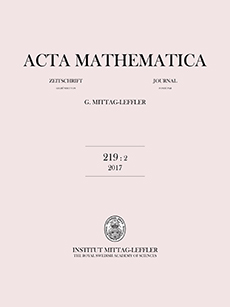Abstract
A set $\Omega \subset \mathbb{R}^d$ is said to be spectral if the space $L^2 (\Omega)$ has an orthogonal basis of exponential functions. A conjecture due to Fuglede (1974) stated that $\Omega$ is a spectral set if and only if it can tile the space by translations. While this conjecture was disproved for general sets, it has long been known that for a convex body $\Omega \subset \mathbb{R}^d$ the “tiling implies spectral” part of the conjecture is in fact true.
To the contrary, the “spectral implies tiling” direction of the conjecture for convex bodies was proved only in $\mathbb{R}^2$, and also in $\mathbb{R}^3$ under the a priori assumption that $\Omega$ is a convex polytope. In higher dimensions, this direction of the conjecture remained completely open (even in the case when $\Omega$ is a polytope) and could not be treated using the previously developed techniques.
In this paper we fully settle Fuglede’s conjecture for convex bodies affirmatively in all dimensions, i.e. we prove that if a convex body $\Omega \subset \mathbb{R}^d$ is a spectral set, then $\Omega$ is a convex polytope which can tile the space by translations. To prove this we introduce a new technique, involving a construction from crystallographic diffraction theory, which allows us to establish a geometric “weak tiling” condition necessary for a set $\Omega \subset \mathbb{R}^d$ to be spectral.
Funding Statement
N. L. was supported by ISF Grants No. 227/17 and 1044/21 and ERC Starting Grant No. 713927.
M. M. was supported by NKFIH Grants No. K129335 and K132097.
Citation
Nir Lev. Máté Matolcsi. "The Fuglede conjecture for convex domains is true in all dimensions." Acta Math. 228 (2) 385 - 420, June 2022. https://doi.org/10.4310/ACTA.2022.v228.n2.a3
Information





